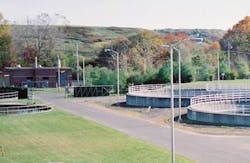Plant No. 1, in North Carolina, is an advanced activated sludge treatment plant. As part of its solids handling process, the town combines its waste activated sludge (WAS) with the WAS imported from two other facilities. The combined solids stream is then aerobically digested. Following stabilization, the sludge is dewatered via centrifuges and thermally dried. To improve its sludge dewatering, the plant uses a high molecular weight cationic polyacrylamide polymer.
Plant No. 2, in Connecticut, consists of primary settlers, trickling filters and activated sludge processes. Its sludge—a mix of 70% primary sludge and 30% WAS—is anaerobically digested and then dewatered by two belt filter presses. The plant uses a Mannich polymer to assist in dewatering.
Solution
Envista Vis is an advanced polymer optimization system that consists of a spectrophotometer that measures the absorbance of light emitted at 191 nm. This patented system consists of integral auto sampling, sample conditioning and sample dilution components. The automated system accounts for the variability in feed sludge quality typical at many wastewater treatment plants.
Envista Vis measures the absorbance of light in a diluted sample of dewatered centrate or pressate at regular intervals. Based upon research on sludge dewatering, a characteristic parabolic curve of absorbance is developed that correlates with the concentration of residual polymer in the sample. (See Figure 1.)
Envista Vis automatically identifies and sets the optimum polymer dose for sludge dewatering. Veolia’s testing demonstrated a polymer savings of up to 30% without any negative impact on final cake solids. The system also demonstrated its ability to reduce operator attention and manpower by automating polymer adjustments while still producing a high-quality end product.
Plant No. 1 Pilot Study: Centrifuge Dewatering
Veolia began two months of full-scale testing at Plant No. 1 in January 2014. Veolia engineers set up the Envista Vis system to sample centrate and perform UV absorbance analysis at the plant’s centrifuges. During the ongoing sampling and analysis protocol, engineers manually increased and decreased the polymer dose in 4% increments to determine the impact of polymer feed rate on dewatered cake solids.
As shown in Figure 1, Envista Vis employed a single-spectrum spectrophotometer to determine the optimum polymer dose. It clearly shows the point of optimized polymer dose in the characteristic absorbance curve. Residual polymer concentration directly correlates to UV-191 absorbance; therefore, where the absorbance value and curve are low, polymer is optimized. The turbidity curve also confirms the optimized dosing point. Figure 1 shows that the optimum polymer dose during testing was 23.5 lb of polymer per dry ton of solids. The system could reduce the plant’s polymer consumption by up to 30% while still maintaining comparable final cake solids.
Plant No. 2 Pilot Study: Belt Filter Press Dewatering
Testing at Plant No. 2 began in September 2014. Veolia engineers conducted testing at one of the plant’s belt filter presses, which use a rotating flocculation drum as the gravity zone. After some testing, Veolia engineers confirmed that the gravity zone made the best location for sample acquisition at this facility.
The testing revealed another way Envista Vis can provide savings to a sludge dewatering operation. The plant’s polymer feed rate had already been optimized by plant staff through experience and by continuous manual adjustments to account for the variability of the incoming sludge. As is the case with many plants, its feed sludge quality can be highly variable, changing over the course of days or even hours. At the plant, Envista Vis successfully predicted an optimal polymer feed rate, which on average was within 10% of the operator-applied feed rate (See Table 1). Envista Vis automatically determined the optimum polymer feed rate without sacrificing any quality in final cake solids.
Envista Vis proved the ability to provide operational savings for sludge dewatering at two sites. First, it showed the potential to save up to 30% on polymer usage while still achieving a quality end product. Second, it provided the opportunity to save on operator time and attention, even at a plant where the polymer dose had already been minimized. This is important, because Plant No. 2 highlighted the often-variable nature of a wastewater plant’s feed sludge.


